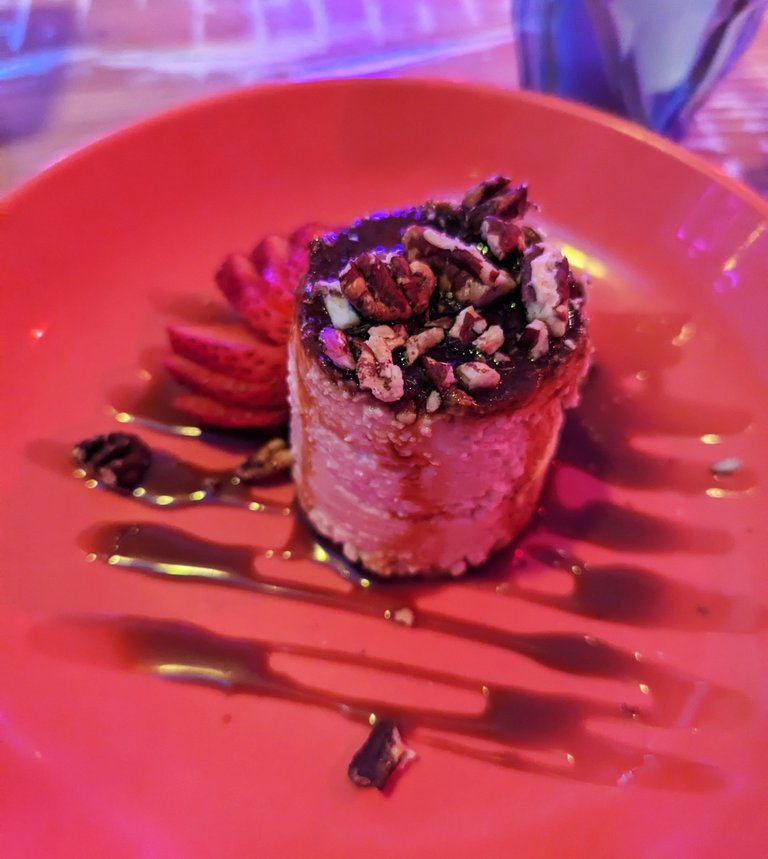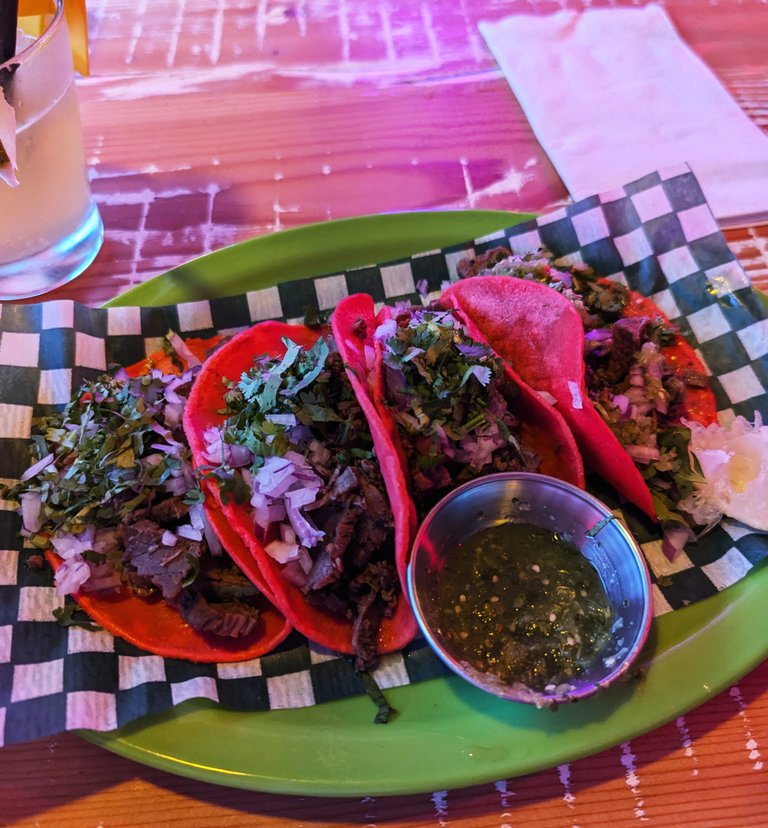Lengua Franca
Thank you for joining me in this Friday culinary adventure. Please take a seat, stick out your tongue, and let's begin.


When the molecules of a substance like food and drink touches the taste receptors on our tongues, they initiate a cascade of electrical currents that travel along this sensory organ, up the spinal cord systems, through the brainstem, along neural pathways to the thalamus, firing in all directions or suppressing signals based on the molecular quality of the stimuli, which are then received, stored, analyzed, and processed to give us the final conscious experience of taste with its range of conscious sensations (sweet, spicy, salty, bitter, and umami).
 Horchata and margarita getting it on with a Corona bottle. Warning: spicy rim
Horchata and margarita getting it on with a Corona bottle. Warning: spicy rimThe taste receptors covering our tongues are sensitive to all kind of flavours, but it has been observed that different areas are more sensitive to some tastes than others. By sensitive, it means that the receptor has a lower activation threshold in the presence of a given compound. Though it should be emphasized that all regions of the tongue work in concert to produce the conscious experience of flavour. The following diagram shows one of the earliest findings on the relationship between taste and tongue sensitivity.

The lower the bar, the more sensitive that area is to the particular taste stimuli. As cited in Coren, Ward, and Enns (1994)
The tip of the tongue is sensitive to sweet an salty flavours. Umami had yet to be included but the tip is also involved. The sides are sensitive to the sourness of the substance. The front and sides are more sensitive to salty flavours. Bitterness is at the front. And so on. The picture is more complex than what I'm presenting here in light of more recent discoveries, but this is the gist of the story.

Dulce de leche goodness

Mexican food is usually "hot" thanks to molecules such as capsaicin, piperine, and other compounds found in the ingredients. Unfortunately, or fortunately as the case may be, Mexican food in this city is not that hot. Our Pacific Northwest palate hasn't reached those levels of spicy nirvana yet. Sensitivity to hot food is located all over the tongue, and our ability to process it involves a host of different neurobiological variables that are too boring to discuss in this post, so here's a picture of tacos.

Muy delicioso!
Lawless and Stevens (1988 as cited in Coren, Ward, and Enns, 1994 ) showed that the tip of the tongue is sensitive to red and black peppers. Thankfully, our taste receptors usually adapt to hot spicy foods (usually with the aid of horchata or some other sweet compound), which is why we can keep on eating them despite the mouth-burning and tongue scraping sensations they elicit.

Tres leches
I hope you enjoyed this dive into the gustatory system. I will leave you with this tasty morsel: there are between 2000-4000 taste buds, each with 50-150 receptor cells. That's a lot of cells waiting to be activated, so make sure you give that tongue a workout this weekend 😜

Resources
- Tongue map - Wikipedia
- Taste buds- Wikipedia
- Michigan State University Taste – Foundations of Neuroscience (msu.edu)
- Coren, S., Ward, L. M., & Enns, J. T. (1994). Sensation and perception (4th ed.). Harcourt Brace College Publishers.
 |  |  |  |
|---|---|---|---|
| X | InLeo | NFT Showroom |
Posted Using InLeo Alpha
If you feel the heat from the food you can let it out by staring eyes to eyes with that angry looking masked-wrestler drawing on the wall.
!LOLZ
lolztoken.com
That’s a bit of a stretch.
Credit: reddit
@litguru, I sent you an $LOLZ on behalf of ekavieka
(1/6)
Farm LOLZ tokens when you Delegate Hive or Hive Tokens.
Click to delegate: 10 - 20 - 50 - 100 HP
That Mexican wrestler looks tough. He can handle the spicy heat 🌶️
Fascinating article. It is said that taste sensitivity decreases with age (over the age of 60). I don't notice that (77), but maybe it's too subtle for it to make a difference. I looked up a Google Scholar article and it explains that the number of taste buds and size generally decrease with age, but that other factors also influence taste sensitivity. These include medicine (as much as 11% of the decline), physical activity and diet. I'm not much of a gourmet, so maybe that's why I don't notice a decline in my taste.
Anyway, good enough article to send me off to look up info :))
I'm happy you found it interesting, @agmoore. The sense of taste is very complex, and it also involves other senses like smell, vision, and even psychological factors. I imagine that with age our senses begin to be less effective, but as you mentioned, we may not even notice those changes. It's great to see that there's research in this area. Thank you for sharing! 🌮🌶️🍷
Food companies and advertising agencies max out on these findings. It's one of the reasons why marketing campaigns and products focus on sweet and salty. I love the taste of "bitter" that comes with freshly harvested vegetables from the garden and of course, bitter chocolate 🥰
Great topic. An ode to our taste buds 😎
I imagine they do so. Understanding the neuroanatomy of how our gustatory system works could be used in this manner by those clever enough to understand the mind-boggling science behind it and put it into action. Although, you don't need to twist my "cognitive" arm to get me to eat tacos. :D
One fascinating thing about the bitter taste is that it is associated to sweetness. Sweet flavours contain organic molecules arranged in specific molecular configurations. For example, many sweet tasting substances have an atomic structure called the ABH system. Paradoxically, some of these substances like saccharide taste sweet in small amounts but bitter in large amounts. Bitter flavours also have a similar ABH system to that of sweet substances. Several other findings also supports the close relationship between sweetness and bitterness. To put it poetically, they're like the yin-yang of the gustatory system. I find that very cool! Thank you for your insightful comment, @kriszrokk. 🍫
🤣🤣🤣
Of course, they are all part of the "whole". Very well put. And once you dissect their chemical compounds and structure, you're fascinated by the insights you gather. Our pancreas, intestines, and liver (to name a few organs) crave bitter. It's like running the machine (our biological computer) on a HQ oil. You will never accomplish that with sweet and/or salty.
Greetings to Canada! Have an amazing day @litguru
What a descriptive piece of writing! And the place is beautiful, the murals and the food above all. I love the salty flavours, more than the sweet ones... the sour ones almost nothing hahaha but everything looks amazing!😄
I wasn't expecting red tacos, but they were delicious. The combination of salty, spicy, sweet, sour, and bitter was a fiesta of flavours. 😄
I leave you all the spice hahaha I don't like it at all!!!!🤣
Food in Mexico is even hotter! We knew a Mexican family, and they invited my family to a BBQ. They had five different kinds of sauces, and the mild one was really hot. I ate some of the other sauces and my mouth was on fire. 😳 I regretted it. And I'm not going to tell you what happened the following day in the bathroom 🔥🔥🔥
For that.... I'll leave you all the spice in the world hahaha I don't want to know anything spicy hahaha
Congratulations @litguru! You have completed the following achievement on the Hive blockchain And have been rewarded with New badge(s)
Your next target is to reach 9000 comments.
You can view your badges on your board and compare yourself to others in the Ranking
If you no longer want to receive notifications, reply to this comment with the word
STOPCheck out our last posts: